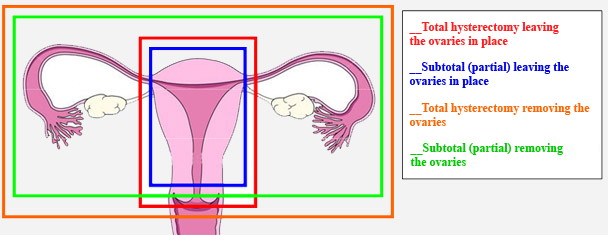The type of hysterectomy depends on whether or not the cervix and/or the annexes (ovaries and Fallopian tubes) remain in place.

In certain situations such as in the presence of cancer (of the cervix or of the corpus of the uterus) when during a total hysterectomy it is considered vital to extend surgery to encompass the ligaments that hold the uterus in place, the procedure is termed an extended hysterectomy and also frequently includes removal of the pelvic ganglions that drain the uterus. This is to fully assess the need for a lymphadenectomy and any additional treatment (radiotherapy, chemotherapy).
A hysterectomy can be performed in different ways.
The method depends on the patient’s obstetric history (number and types of deliveries, babies’ birth weights), her general health history (size of uterus, anatomy of pelvis), the reason for surgery, and the experience and training of the surgeon:
Abdominal hysterectomy using traditional surgical procedures with a laparotomy (incision of the abdomen wall)
Laparoscopic or coelioscopic hysterectomy where the surgeon is guided via a lighted camera
(see laparoscopy)
Vaginal hysterectomy where the uterus is removed through an incision in the vagina which is subsequently sutured


